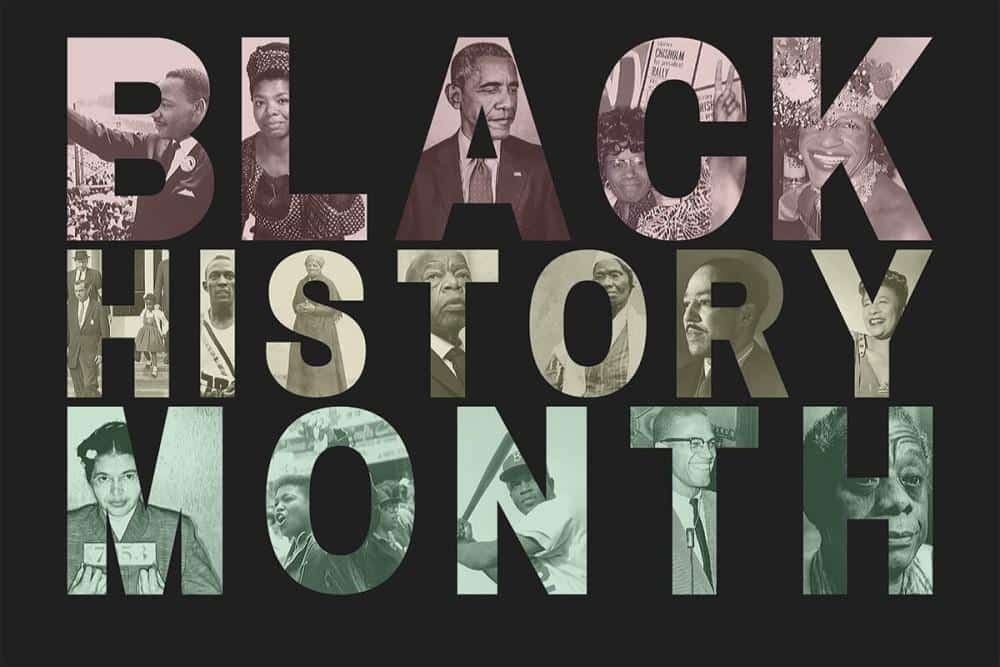Staff Writer
Black History Month has its roots in the early 20th century when historian Carter G. Woodson and the Association for the Study of Negro Life and History designated the second week of February as “Negro History Week” in 1926. They chose this week to coincide with the birthdays of Abraham Lincoln and Frederick Douglass, two key figures in African American history.
The aim was to highlight the contributions of African Americans and promote a more accurate and inclusive historical narrative. Over time, the celebration expanded, gaining widespread recognition and support. In 1976, President Gerald Ford officially recognized February as Black History Month, urging the public to “seize the opportunity to honor the too-often neglected accomplishments of black Americans in every area of endeavor throughout our history.”
Since then, Black History Month has evolved into a time for education, reflection, and celebration of the achievements and impact of African Americans on the nation’s history and culture. It serves as a reminder of the ongoing struggle for civil rights and equality while honoring the rich legacy of the African American community.
Top ten black history figures from Cleveland Ohio:
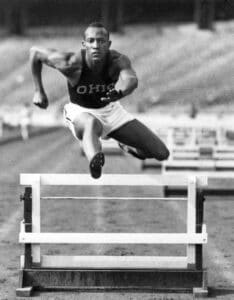
Jesse Owens:
- Jesse Owens (1913–1980) was an African American track and field athlete who became a global sports icon for his remarkable achievements during the 1936 Berlin Olympics. Born on September 12, 1913, in Oakville, Alabama, Owens grew up in a racially segregated America.
- At the Berlin Olympics, Owens defied Adolf Hitler’s notion of Aryan racial superiority by winning four gold medals in track and field events: the 100 meters, 200 meters, long jump, and 4×100 meters relay. His victories not only showcased his exceptional athletic prowess but also challenged racial stereotypes and discrimination.
- Despite his triumphs, Owens returned to the United States to face racial segregation and limited opportunities. He struggled financially but later found success as a motivational speaker, sports ambassador, and goodwill ambassador for the U.S. State Department.
- Jesse Owens’ legacy extends beyond his athletic achievements. His courage and excellence served as a symbol of resilience against racism and injustice. Owens remains an inspiration, and his impact on breaking down racial barriers in sports and society is widely recognized.
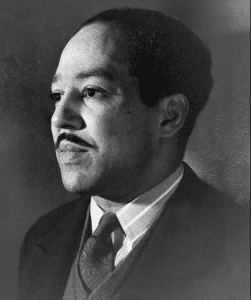
Langston Hughes:
- Langston Hughes (1902–1967) spent a significant part of his childhood in Cleveland, where he attended Central High School. A leading figure of the Harlem Renaissance, a cultural and artistic movement that flourished in the 1920s in Harlem, New York. Born on February 1, 1902, in Joplin, Missouri, Hughes became a prolific and influential poet, essayist, playwright, and novelist.
- Known for his innovative and soulful expressions of African American life, Hughes’ poetry often celebrated the beauty, strength, and resilience of Black culture. His works explored themes of identity, race, and social justice, making him a central figure in the literary and artistic exploration of the African American experience.
- Some of his most notable works include the poem “The Negro Speaks of Rivers,” the play “Mulatto,” and the novel “Not Without Laughter.” Hughes’ writing was deeply rooted in the rhythms of jazz and blues, capturing the essence of the Harlem Renaissance and influencing generations of writers.
- In addition to his literary contributions, Langston Hughes was a social activist, using his work to address racial inequality and advocate for civil rights. His impact on American literature and culture endures, and he is celebrated for his enduring legacy as a key figure in the artistic and intellectual awakening of African American consciousness during the Harlem Renaissance. Langston Hughes passed away on May 22, 1967, but his work continues to inspire and resonate with readers worldwide.
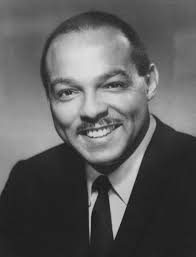
Carl Stokes:
- Carl Stokes (1927–1996) was an American politician and the first African American elected mayor of a major U.S. city. Born on June 21, 1927, in Cleveland, Ohio, Stokes made history with his election as the mayor of Cleveland in 1967.
- Before entering politics, Stokes served in the U.S. Army and earned a law degree. He began his political career as a member of the Ohio state legislature. In 1965, he unsuccessfully ran for mayor but gained significant support and experience.
- In 1967, Stokes ran for mayor again and achieved a historic victory, becoming the first African American mayor of a major city with a predominantly white population. His tenure as mayor was marked by efforts to improve race relations and address urban issues.
- Stokes worked to reform the police department, increase minority representation in government, and improve living conditions in Cleveland’s neighborhoods. He emphasized economic development and education initiatives during his two terms in office.
- After leaving the mayor’s office in 1971, Stokes continued to be involved in public service and served as the U.S. ambassador to the Republic of Seychelles from 1994 to 1996.
- Carl Stokes played a crucial role in breaking racial barriers in American politics, and his achievements paved the way for other African Americans in leadership positions. His legacy is remembered for promoting inclusivity and addressing social issues during a pivotal time in U.S. history. Carl Stokes passed away on April 3, 1996.
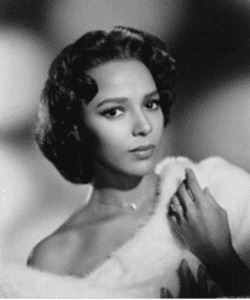
Dorothy Dandridge:
- Dorothy Dandridge (1922–1965) was an American actress, singer, and dancer who broke barriers as one of the first African American women to achieve success in Hollywood. Born on November 9, 1922, in Cleveland, Ohio, Dandridge began her career in show business at an early age, performing in a family musical act called The Dandridge Sisters.
- Dandridge’s breakthrough came with her role in the film “Carmen Jones” (1954), where she received critical acclaim and became the first African American woman nominated for an Academy Award for Best Actress. This achievement was a significant milestone in the history of African American representation in Hollywood.
- Throughout her career, Dandridge faced racial discrimination and limited opportunities due to the prevailing racial prejudices of the time. Despite these challenges, she continued to pursue acting and singing, leaving an indelible mark on the entertainment industry.
- Dorothy Dandridge’s performances showcased her talent, beauty, and charisma. She continued to make notable contributions to film and music, starring in productions like “Porgy and Bess” (1959) and “Island in the Sun” (1957).
- Tragically, Dorothy Dandridge faced personal and financial struggles, and her career experienced a decline in the 1960s. She passed away on September 8, 1965, at the age of 42. Despite the challenges she faced, Dorothy Dandridge is remembered as a trailblazer who paved the way for future generations of African American actresses and left an enduring legacy in the entertainment industry.

Garrett Morgan:
- Garrett Morgan (1877–1963) was an African American inventor and entrepreneur best known for his significant contributions to traffic safety and industrial safety devices. Born on March 4, 1877, in Paris, Kentucky, Morgan’s inventions had a lasting impact on public safety.
- One of Morgan’s most notable inventions was the development of the three-position traffic signal, which he patented in 1923. This innovation included the addition of a warning signal, helping to improve road safety by providing clearer instructions to drivers. Morgan’s traffic signal played a crucial role in shaping modern traffic management systems.
- In addition to his work on traffic safety, Garrett Morgan invented the safety hood or gas mask in 1914. Originally created to protect workers from inhaling toxic fumes while working in mines, it later gained significance during emergencies such as fires. Morgan’s safety hood was used by firefighters and became a vital tool for personal safety in hazardous environments.
- Despite facing racial discrimination during his lifetime, Garrett Morgan’s inventions had a lasting impact on public safety, and he received recognition for his contributions. He also owned and operated a sewing machine repair business and a tailoring shop.
- Garrett Morgan passed away on July 27, 1963. His legacy lives on as a pioneering African American inventor whose innovations continue to benefit society, particularly in the fields of traffic management and industrial safety.
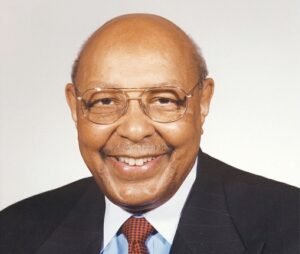
Louis Stokes:
- Louis Stokes (1925–2015) was an influential American politician and the first African American congressman from the state of Ohio. Born on February 23, 1925, in Cleveland, Stokes served in the U.S. Army during World War II before pursuing a legal career.
- Stokes earned his law degree from Cleveland-Marshall College of Law and became a prominent civil rights attorney. In 1968, he made history by winning election to the U.S. House of Representatives, representing Ohio’s 21st Congressional District. Stokes went on to serve 15 consecutive terms in Congress, making him one of the longest-serving African American members in history.
- Throughout his congressional career, Stokes advocated for civil rights, education, and healthcare. He played a key role in investigating the assassinations of President John F. Kennedy and Dr. Martin Luther King Jr. as a member of the House Select Committee on Assassinations.
- Louis Stokes was known for his dedication to public service and his commitment to addressing issues affecting African Americans and marginalized communities. He co-founded the Congressional Black Caucus in 1969, becoming its first chairman.
- Stokes retired from Congress in 1999, leaving a lasting legacy as a trailblazer and advocate for equality. He passed away on August 18, 2015, but his impact on American politics and civil rights continues to be celebrated.

Halle Berry:
- Halle Berry, an Academy Award-winning actress and producer, was born on August 14, 1966, in Cleveland, Ohio. Berry rose to fame for her breakthrough role in “Monster’s Ball” (2001), where she made history as the first African American woman to win the Oscar for Best Actress.
- Before her Oscar win, Berry gained recognition for her work in films such as “Boomerang” (1992), “X-Men” (2000), and “Swordfish” (2001). Her performances have consistently showcased her talent and versatility as an actress.
- In addition to her success in film, Berry has been involved in television, starring in series like “Extant” (2014-2015) and “Bruised” (2021), where she made her directorial debut. As a producer, she has been actively involved in projects that champion diverse voices and narratives.
- Beyond her career in entertainment, Halle Berry is an advocate for social justice causes and women’s empowerment. She continues to be a trailblazer, breaking barriers for women of color in the film industry.
- Halle Berry’s impact on Hollywood and her commitment to diversity make her a respected figure in the entertainment world. With her enduring talent and dedication to meaningful storytelling, she remains a prominent and influential force in the film industry

Charles Oakley:
- Charles Oakley, a former professional basketball player renowned for his toughness and defensive prowess, was born on December 18, 1963, in Cleveland, Ohio. Playing the power forward position, Oakley enjoyed a successful career in the National Basketball Association (NBA) known for his tenacity on the court.
- Oakley’s NBA career spanned from 1985 to 2004, during which he played for several teams, including the Chicago Bulls, New York Knicks, Toronto Raptors, Washington Wizards, and Houston Rockets. He achieved significant acclaim during his tenure with the New York Knicks from 1988 to 1998, earning the reputation as one of the league’s premier enforcers and rebounders.
- Known for his fierce competitiveness and physical style of play, Oakley became a fan favorite and a vital part of the Knicks’ success in the 1990s. His contributions to the team’s defensive efforts and leadership on the court left an enduring impact on the franchise.
- Post-retirement, Oakley has remained involved in basketball-related activities, including coaching and various philanthropic initiatives. He continues to be recognized as a basketball icon, remembered for his indomitable spirit and contributions to the sport.
- Charles Oakley’s legacy extends beyond the basketball court, solidifying his place as a revered figure in NBA history. His resilience, dedication to the game, and commitment to excellence have left an indelible mark on the sport of basketball.
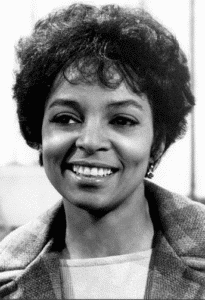
Ruby Dee:
- Ruby Dee, an iconic American actress, poet, playwright, and civil rights activist, was born on October 27, 1922, in Cleveland, Ohio. Dee’s remarkable career spanned seven decades, leaving an indelible mark on stage and screen.
- Dee began her acting career in the 1940s, becoming known for her powerful performances in theater productions such as “A Raisin in the Sun” (1959) and “Purlie Victorious” (1961). Her on-screen work included notable films like “A Raisin in the Sun” (1961), “Do the Right Thing” (1989), and “American Gangster” (2007).
- Throughout her career, Dee received critical acclaim and numerous awards, including an Emmy Award, a Grammy Award, and the Screen Actors Guild Life Achievement Award. Alongside her husband, Ossie Davis, Dee formed a dynamic artistic and life partnership, often collaborating on projects that addressed social issues and promoted civil rights.
- Dee was a passionate advocate for social justice, actively participating in the Civil Rights Movement alongside influential figures like Martin Luther King Jr. She used her platform to address issues of racial and gender inequality, becoming a respected voice for change.
- In addition to her acting prowess, Ruby Dee was a skilled poet and playwright, contributing to the literary landscape with her thoughtful and impactful work.
- Ruby Dee’s legacy is characterized by her artistry, activism, and unwavering commitment to social justice. She passed away on June 11, 2014, but her contributions to American culture and the fight for equality continue to inspire generations.
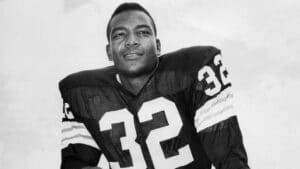
Jim Brown:
- Jim Brown, an American football legend, actor, and activist, was born on February 17, 1936, in St. Simons, Georgia. Brown’s impact on the National Football League (NFL) and his contributions beyond the football field have solidified his status as one of the greatest athletes of all time.
- Beginning his professional football career in 1957 with the Cleveland Browns, Jim Brown quickly emerged as a dominant force on the field. Renowned for his exceptional speed, power, and agility, he set numerous records and achieved remarkable success during his nine seasons in the NFL.
- Brown’s list of accomplishments includes eight Pro Bowl selections, three MVP awards, and leading the league in rushing yards eight times. His extraordinary achievements prompted his induction into the Pro Football Hall of Fame in 1971, despite his relatively short playing career.
- Post-retirement from football, Brown seamlessly transitioned into acting, with notable roles in films such as “The Dirty Dozen” (1967) and “I’m Gonna Git You Sucka” (1988). Beyond entertainment, he became an influential advocate for civil rights and social justice.
- Jim Brown’s commitment to activism and community service became evident through initiatives such as the Amer-I-Can program, aimed at empowering individuals to lead successful lives. His impact extended far beyond the realms of sports and entertainment, making him a respected figure in the fight for equality.
- As an enduring symbol of athletic excellence, Jim Brown’s legacy encompasses his achievements on the football field, his contributions to the entertainment industry, and his unwavering dedication to social change. His influence as a multi-faceted individual continues to resonate, shaping conversations about sports, activism, and cultural impact.
Approach Black History Month with respect, authenticity, and a commitment to fostering understanding and unity. It is an opportunity to recognize the achievements, struggles, and resilience of the African American community throughout history.

